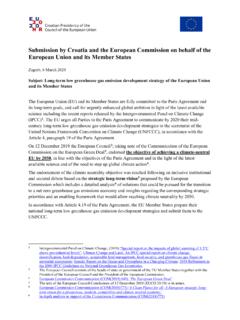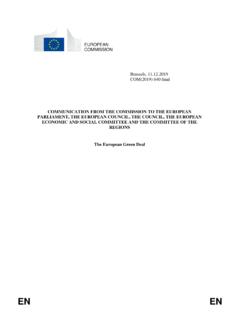Transcription of Guidelines for Inclusive Communication
1 #UnionOfEqualityEuropean commission Guidelines for Inclusive Communication Photo by Humphrey Muleba - Unsplash 2 CONTENTSFOREWORD 4 INTRODUCTION 5 GENDER 9 LGBTIQ 13 RACIAL & ETHNIC BACKGROUND 17 CULTURES, LIFESTYLES OR BELIEFS 19 DISABILITIES 21 AGE 25 ONLINE ACCESSIBILITY REQUIREMENTS 273 FOREWORD Equality and non-discrimination are core values of the european Union. They apply directly to our work as an institution both in our internal and external policies as well as in the way we function within. The european commission must lead by example in its quest towards a Union of equality. To do this effectively, we must deliver Inclusive Communication at all times, thus ensuring that everyone is valued and recognised in all our material regardless of their gender, racial or ethnic origin, religion or belief, disability, age or sexual orientation. This is what United in Diversity truly means. People need to see a positive version of themselves in our Communication .
2 To meet this expectation we need to critically assess our use of language and visuals in terms of the diversity of representation and how different groups are Guidelines deliver exactly that. Helena DalliCommissioner for Equality4 INTRODUCTION Everyone in the european Union has an inherent right to be treated equally, and hence to be included and represented, regardless of their gender, racial or ethnic origin, religion or belief, disability, age or sexual orientation. Besides, people are complex beings with multiple characteristics and identities. It is therefore important to reflect this in our Communication to ensure that no one is left words and images we use in our daily Communication convey messages about who we are as well as who we are not. They can therefore indirectly pass messages about who is included in our understanding of society, and by inference who is not. They reveal our own assumptions and biases and may perpetuate commonly held negative bias and stereotypes.
3 In turn, this can also legitimise or even encourage marginalisation and discrimination. The european commission s work must value and empower everyone in the EU, in all their diversity. The use of language, imagery and audio-visual products must therefore be consistent with this objective. Inclusive Communication emanates from the core european values of equality and non-discrimination. It reflects the european Union s motto United in diversity . As a public institution, we must lead by example. Deep-rooted stereotypes and biases affect individual and collective behaviours, and words and attitudes in the workplace can cause lasting harm. Diversity is our strength and should be addressed at all levels. Scope and purpose of this documentThe purpose of this document is to set common standards for Inclusive Communication and to provide practical examples and advice to all commission colleagues. This concerns both external 1 Link to commission Style Guide: , in particular Part One, section F (pp.)
4 44-45) on Inclusive language2 These Guidelines focus on general principles and examples in English. For considerations on Inclusive language in other EU languages, see the series published by DG Translation on its intranet: 3 A wealth of training materials are available on DG Translation s clear writing page: internal Communication . The recommendations in this document may be useful for producing any type of Communication material, including: Press material (press releases and Q&As) Factsheets and infographics Social media posts and visuals Training materials and presentations Material used in internal Communication Speeches and op-eds Guidelines build on the existing commission Style Guide1 and encompass various aspects of Inclusive Communication , from written to visual communications and IT requirements for greater general principlesTo improve outreach to target audiences, Communication about the EU s activities should be written in clear and simple language, avoiding unnecessary difficult phrasing, jargon and Communication in all EU languages is a well-established principle for material targeting a general audience.
5 Similarly, the availability of multilingual interpretation services at events is common practice. Communication visuals should systematically reflect the diversity of the EU population and not only portray the limited number of profiles that are typically available in stock photography. This must be done both in terms of the diversity of national attributes as well as diversity based on personal changes over time, across cultures and generations. You are encouraged to stay curious and to be open and ready to update your language as appropriate. These Guidelines are full of suggestions to help you communicate effectively and sensitively, and incorporate a more Inclusive approach into your work, whether it is in how you draft a text or organise an be followed at all timesWhile part of these Guidelines content is designed to give suggestions and help you reflect and find your own Inclusive Communication style, some rules must always be followed when you communicate on behalf of the commission , regardless of your particular situation or personal stance.
6 These include: Never use gendered nouns such as workmen, policemen or masculine pronouns (he, his) as a default. Do not organise panel discussions with only one gender represented, aim for gender balance instead. When using a variety of visuals, testimonies and stories, ensure that they reflect diversity in all its senses. Do not use Miss or Mrs, unless it is the explicit preference of the person addressed; use Ms universally. When asking about gender, do not offer only male/female options, add other and prefers not to say . Never address an audience as ladies and gentlemen but use expressions such as Dear colleagues . Do not reinforce in your visual or written Communication harmful stereotypes on gender, age, ethnic groups, etc. Do not use the word citizens to refer to people in general. Do not assume anyone s sexual orientation. When addressing trans people, always respect self-identification. Do not refer to the elderly , use older people instead.
7 Referring to persons with disabilities, use people-first language ( John Doe has a disability , not John Doe is disabled ). Do not use terms with a negative connotation such as suffering from HIV , suffering from autism , wheelchair-bound (use with HIV , with autism , wheelchair user instead). Ensure that your Communication products always comply with accessibility Guidelines , in particular web pages, pdfs, and forms used for example in public consultations. Never outsource Communication products without specifying accessibility and inclusion requirements in the contract terms. In the following chapters you will find more details on the reasons and the context for these rules, together with a wealth of additional checklist for preparing Inclusive Communication material1 PRELIMINARY CONSIDERATIONSWho am I targeting with my Communication ?How can I make sure to reach all people within my target group, regardless of their possible disabilities, or their gender, sexual orientation, ethnic origin, socio-educational background, Inclusive TEXTAm I using the right language to ensure that I reach my target audience?
8 Am I avoiding jargon?Am I using gender-sensitive, diversity-sensitive language? Could it be appropriate to create an easy-to-read version of my text?3 Inclusive IMAGESAm I ensuring that I do not represent gender, age, ethnic and other groups in a stereotypical way?Do my selected images fully represent european societies in their diversity of genders, racial and ethnic backgrounds, abilities, or do all the people represented belong to the same specific group?Am I ensuring that people with visual impairments can access the key message that the image conveys?4 Inclusive EVENTSAre my event venues and services accessible to people with disabilities?Are my panels diverse and gender-balanced?5 ACCESSIBILITYHave I checked that forms, pdf files, documents, web pages comply with accessibility requirements?Have I provided alternatives to access visual content for people with visual impairments (alternative texts or transcripts that can be read by a screen reader)?
9 Have I provided alternatives to access audio content for deaf people (transcripts, subtitles, International Sign Language or other sign language interpretation)?6 FINAL CONSIDERATIONWho may I be leaving out?78 GENDER Key messagesGender-sensitive language treats different genders equally and positively. It is aware of stereotypical perceptions of gender roles and is used actively to undo commission Style Guide sets out the basic principles: Avoid nouns that appear to assume that one gender rather than another will perform a particular role: chairman is the most obvious example. Gender-neutral noun forms ( chair , spokesperson , etc.) are preferred. Avoid gender-specific pronouns for people whose gender is unknown. It is preferable to use they or reformulate the sentence so that no pronoun is needed, or use he or she , s/he (albeit this option is falling out of favour) should avoid expressions that may be little one of the genders or reinforce harmful stereotypes.
10 Dos and don tsWhen referring to women, avoid the titles Miss or Mrs, which unnecessarily reveal a woman s marital status, unless they prefer to self-identify as such. Use Ms instead. Pay attention to not always mentioning the same gender first in the word order, or addressing men and women differently ( a man by family name, a woman by first name).When choosing images to accompany your Communication , make sure that women and girls are not represented in domestic or passive roles while men are active and adventurous. You should also ensure diversity in terms of racial and ethnic origins, and other aspects of diversity, including body shape and See also for reference the european Parliament s multilingual Guidelines on Gender neutrality in the language used in the european Parliament , first published in 2008 and revised in 2018, which aims to ensure that non-sexist and gender- Inclusive language is used in the Parliament s documents and communications in all official languages.


